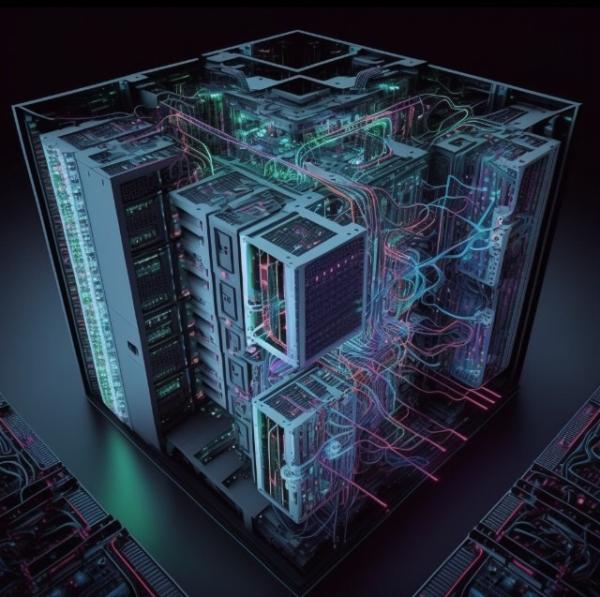BY LETTER
Computer
Technology > Application > Computronics
Technology > Technology Type or Material > Drytech/Hylotech
Technology > Technology Levels > High Tech / Hitech
Technology > Technology Levels > Middle Tech / Midtech
Technology > Technology Type or Material > Nanotech
Technology > Technology Type or Material > Organic/Biotech
Technology > Technology Levels > Transapientech / Godtech / Clarketech
Technology > Technology Type or Material > Drytech/Hylotech
Technology > Technology Levels > High Tech / Hitech
Technology > Technology Levels > Middle Tech / Midtech
Technology > Technology Type or Material > Nanotech
Technology > Technology Type or Material > Organic/Biotech
Technology > Technology Levels > Transapientech / Godtech / Clarketech
 Image from Keith Wigdor and Midjourney AI |
Key components
Hardware- Central Processing Unit (CPU): Often referred to as the brain of the computer, the CPU executes instructions from programs.
- Memory (RAM): Random Access Memory is used for temporarily storing data and program instructions that the CPU is currently using or processing.
- Storage: This includes devices like hard drives and solid-state drives, used for long-term data storage.
- Input Devices: Devices like keyboard, mouse, joystick, haptic gloves, allow users to input data and commands into the computer.
- Output Devices: Monitors, printers, and speakers are examples of output devices that display or provide results.
- Operating System (OS): Software that manages hardware resources and provides services for computer programs.
- Applications: Software programs designed for specific tasks, such as word processors, web browsers, or graphic design software.
Concepts
Data Representation: Computers use binary code (0s and 1s) to represent and process data. Information is encoded in binary, and operations are performed using binary logic.Algorithms and Programs: Computers execute instructions provided by algorithms, which are step-by-step procedures or formulas for solving specific problems.
Programs are sets of instructions written in programming languages that tell the computer how to perform a particular task.
Automation: Computers excel at automating repetitive tasks, allowing for increased efficiency and precision.
Communication: Computers can communicate with each other through networks, enabling data exchange and collaborative processing.
Evolution: Computers have evolved over time in terms of size, speed, and capabilities. This evolution is often described by concepts like Moore's Law, which predicts an increase in computing power over time.
Computers have continued to evolve during millenia and in the 11th millenia After Tranquility, they may be sentient or non-sentient, made of biological material or nanotechnology.
AIs can be either sentient computers, or complex systems residing in the RAM of computers. Without computers, galactic civilization would be impossible.
Types
- Analog computer
- Digital computer
- Hybrid computer
- Harvard architecture
- Von Neumann architecture
Glossary
Computation: Any type of calculation that is well-defined (whether these are, arithmetic, non-arithmetic or logical operations). Common examples of computations are mathematical equations and computer algorithms.Harvard architecture: A computer architecture with separate storage and signal pathways for instructions and data.
Von Neumann architecture: A computer architecture where program instructions and data share the same memory and pathways.
Related Articles
- Computation
- Computer Engineering
- Computer Science - Text by Adapted by M. Alan Kazlev from the original write-up by Robert J. Hall
The theoretical and practical application of computational devices, including hardware, firmware and software architecture, programming skills, simulation techniques, customized algorithms and dedicated aioids, virtualics, networking, parallel programming, intelligent subroutines, information storage, comparative machine-level low level, and intermediate level operating systems, and subturing artificial intelligences. - Computronium
- Computronium Node
Appears in Topics
| Computronics | Drytech/Hylotech | High Tech / Hitech |
| Middle Tech / Midtech | Nanotech | Organic/Biotech |
| Transapientech / Godtech / Clarketech |
Development Notes
Text by Avengium
Initially published on 24 September 2001.
expanded on 12/15/23 from a stub article by M. Alan Kazlev
Initially published on 24 September 2001.
expanded on 12/15/23 from a stub article by M. Alan Kazlev






